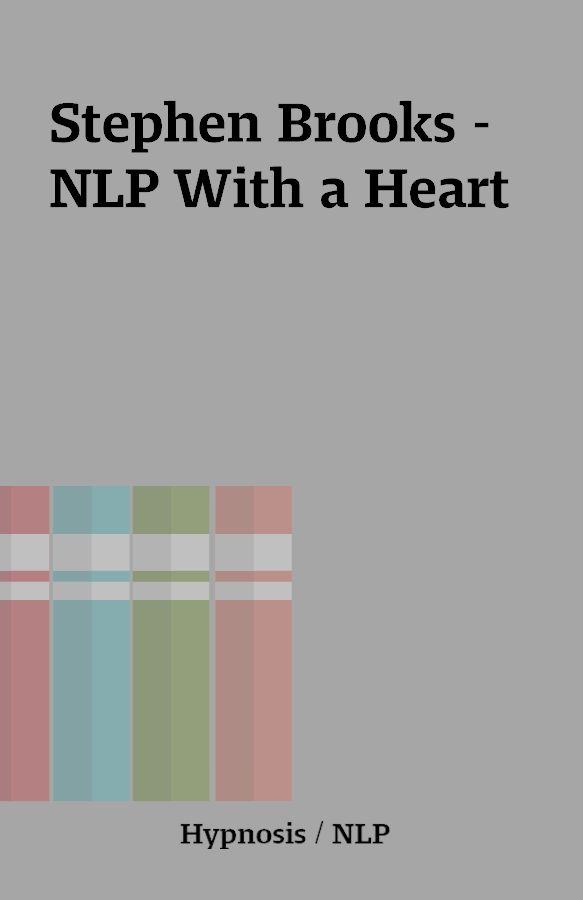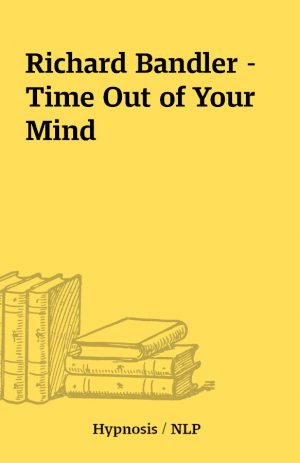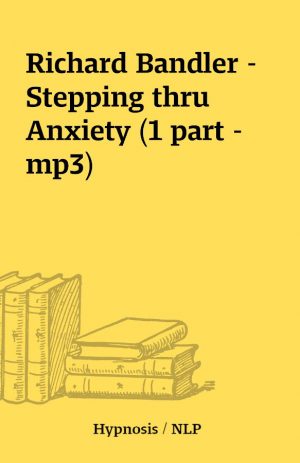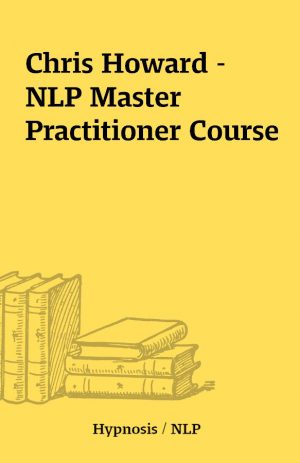Stephen Brooks – NLP With a Heart
Stephen Brooks – NLP with a Heart
[1 Audio DVD – 12 mp3s]
Description
This is a unique recording of Brooks teaching trainee health professionals at a London Hospital. This set of 14 recordings are the complete recordings of a four day training course. Brooks was often frustrated by the mechanical way that NLP was taught on training courses in the 1980’s and he spent a lot of time in trying to promote the teaching of NLP in a caring way. His way of doing this was to put it back into the context of Ericksonian Hypnosis and call it NLP With A Heart.Side Note: Stephen Brooks is the original teacher of Igor LedochowskiContents include:• Why Are You Here?• Healing With Words• Erickson’s Principle of Utilizing Resistance• Case Study – Prescribing the Symptom – Utilizing nervousness as a trance induction by frustrating trance as a double bind• Fuzzy Language and Specifying Outcomes• Freeing Up Limiting Maps• Sensory Learning – Hearing / Seeing /Feeling Exercise Format• Applying Skills In Context• Presuppositions Taught By Example• Maps and Territory – The Vase and Flower Example• Brief History of Erickson and NLP• Erickson Story – Footsteps In The Snow• NLP – Modelling Excellent Therapists• Putting NLP Patterns Back Into Hypnosis• Sensory Experience – Making Sense Of The World• Sensory Dependence – Woman In A Bank Example• Natural Reality and Man-made Reality• Thinking You have A Problem• Changing Brain Patterns• Front Door Demonstration – Superimposing Realities• Hypnosis – Shifting From External to Internal Reality• What Happens When You Go Into Trance – Hypnosis Graph• Examples of Brief Everyday Trance Experiences• Analysis of a Beach Induction• Modalities and Sub-modalities• Replicating Reality• Changing Thought and Feelings – Group Demonstration• Why Some Problems Are Difficult To Remove• Retaining Memories Without The Feelings• Sub-modality Therapy Demonstration – Rewriting Embarrassing Memories• Analysis of the Session• Analogy about Commitment – Future Pacing Collecting For Charity• Patient’s Account of the Session• Testing the Therapy – Patient’s Inability to Find Feelings• Using the Technique with Patients Who have Difficulty Visualizing• Demonstration – How to get Someone to Visualize• Reluctance to Visualize Because of Childhood Nightmares• Case Study – Kicking Legs• The Relationship Between Triggers and Feelings• What Kind of Problems to Work On• Training Exercise Format• Group Feedback• Case Study – Dog Phobia• More Group Feedback and Analysis• Waiting For Unconscious Responses• Therapy Occurs when the Therapist Stops Talking• Analysis of a Sub-modality Exercise• Using Sub-modalities to Generate Further Success• Sub-modalities for Pain Control• The Function of Pain• Demonstration – Pain Removal Using NLP with Ericksonian Hypnosis• Case Study – Pain Control• Analogy – Pain Control and the Power of Hypnosis• Demonstration – Rapport Building Through Body Posture• Analogy – Looking for Matching Behaviour in Public Places• Pacing and Leading• Other Behaviours and Physiology to Match• Demonstration – Matching Breathing / NLP and Ericksonian Hypnosis• Matching Mirroring Exercise• Analysis of the Exercise• Matching and Mismatching• Task – Walking In Step• Eye Accessing Cues• Analogy – Mastermind• Representational Systems• Case Study – Eye Accessing for Relationship Therapy• Case Study – Changing Eye Accessing Cues To Treat Depression• 2nd Case Study – Changing Eye Accessing Cues To Treat Depression• Literality and Contextualization in Hypnosis• Recognition and Influencing Pupil Dilation for Trance• Eye Accessing and Decision Making• Left Handed Accessing Cues• Challenging Presupposed Accessing Cues• Eye Access Cues Exercise – Creating Sensory Specific Questions• Using the Olfactory Sense for Age Regression• Paradoxical Self Help for Depression• Using Eye Accessing for Diagnosing the Cause of Problems• Working with Multiple Personalities• Using Humour in Therapy• Case Study – Using Non-verbal Behaviour for Diagnosis• Therapy Demonstration – Effortlessly Changing Severe Problems Using only Eye Accessing• Therapy Demonstration – Part Two – Reframing• Avoiding Content• Saying Thank You to Your Problem• Therapy Demonstration Continued from MP3 5• Future Pacing Plus an Explanation• Observing Breathing, Posture and Blink Reflex• Watching How Internal Changes Affect Physiology• The Difference between Observation and Interpretation• Discussion About the Patient’s Subjective Experience• Minimal Cues of Trance• Hypnotising a Member of the Audience• Analogue Marking• Insertive Eye Contact• Case Study – Literalness in Trance• Skin Colour Analysis• Levels Of Trance• Patients Falling Asleep• The Therapy Chair and Patient Comfort• Who Can Be Hypnotized• Deepening Technique• Resistance – Using Double Binds• Minimal Cues Associated with Accessing Cues• Minimal Cues Associated with Accessing Cues• Description of Professions Associated with Accessing Cues• How to Communicate According to A Patient’s Accessing Cues• Sensory Language Predicates• Language of Different Professions• Analogy – Correct use of language in a School Context• Creating Sensory Based Predicates• Examples Of Predicates• Predicate Exercise• Analysis of the Exercise• How To Learn through Limiting Oneself to Individual Skill Building• Putting Everything Into Practice• Therapy Demonstration• Checking for Previous Experiences of Hypnosis• Utilizing Leisure Interests as a Trance Induction• Accessing and Comparing Trance States• Re-directing Attention to Physiological Changes• Contingent / Dependent Suggestions Using the Word “Asâ€â€¢ Trance Deepening Demonstration• Evoking Changes in the Patient’s Subjective Kinesthetic Experience• Using Contingent / Dependent Suggestions with Progressive Relaxation• Hypnotherapy by Talking to The Unconscious• Future Pacing and Deepening Processes• metaphor – Sunflower• Analysis of the Therapy Demonstration• Accessing Resources• Taking Responsibility As A Therapist• Ratification v Testing• Age Regression• Bringing the Patient Out Of Trance• The Patient Shares his Subjective Experience of Trance• Breakdown of Hypnotic Technique and Language Used• Overloading and Confusion• Analysis Of Ericksonian Language Patterns• Utilizing the Law of Reversed Effect• Case Study – Chocolate Compulsion• Focusing on Positives• Discussion of the Sunflower metaphor• Discussion about Trance Depth• Case Study – Lift Phobia• Feedback Not Failure• Prescribing a Relapse – Turning Failure Into Success• Exercise – Trance Induction Using Leisure Activity• Exercise Analysis• Timing and Pace of the Trance Induction• How much to Talk – When Not to Talk• Judging Trance Depth by Watching Physiology• Trance Language• Examples of Contingent / Dependent Suggestions• Anchoring and Conditioning Triggers to Responses• Analogy – Using Indirect Suggestion in Everyday Life• Practicing Hypnotic Skills in Everyday Life• Stages in a One Hour Hypnotherapy Session• Using Creative Moments• Pausing During Trance for Processing and Integration• Giving metaphors• Giving the Patient Ratification During the First Session• Recognising Patients Who Don’t Want to get Better• Analogy – Getting Commitment – Beachy Head metaphor• Fast Food Therapy – Getting Patients In and Out Of Therapy• Checking On the Results of Your Therapy• Hypnotizing Patients Who Cannot Hear• Hypnotizing Patients Through Mime and Interpreters• Being Creative With Your Techniques• Case Study – Tinnitus• Techniques for Treating Tinnitus – Changing the Frequency Response• Building Rapport With Your Tinnitus• Getting Tinnitus To Play a Tune• Singing in Harmony With Tinnitus• Accepting Symptoms as a Way to Removing Them• Case Study – Relationship Therapy• Using Hypnosis With Psychiatric Patients• About Only Using Hypnosis Within Your Profession• Working With Psychotics• Information Gathering• Being Specific• Nominalizations• Asking What, Where, Who, How and When Questions• Case Study – Getting the Patient to Demonstrate Their Symptom• Case Study – Relationship Problem – Directing Minimal Cues• Getting Video Descriptions• Case Study – Bulimia – Tasking• Collecting Guru Speak Nominalizations• Identifying and Challenging Nominalizations• Nominalization Exercise – Challenging Artfully Vague Language• Analysis of the Exercise• Keeping Meetings on Target By Challenging Nominalizations• Creating Positive Nominalizations• Demonstration – Hypnotizing One Person While Talking to Another• The Reason for Giving Positive Nominalizations• Using Nominalizations for Creating Confusion• Using Ambiguity• Using Dangling Phrases• Analogue Marking• Converting Direct Suggestions Into Indirect Suggestions• Examples of Integrating Indirect Suggestions• Exercise – Using Indirect Hypnosis• Discussion About the Exercise• Discussion About the Importance of Practice• Anchoring and Classical Conditioning• Quick Demonstration with Member of the Group• Using Trigger / Response to Change Patterns• Associating Feeling Good with Learning• Re-initiating Trance in a Member of the Group• Conscious Triggers Triggering Unconscious Responses• Case Study – Everyday Anchoring in a Relationship• Therapy Demonstration Using Sub-modalities Combined With Anchoring• Accessing the Problem State• Accessing Resources and Amplifying Intensity with Sub-modalities• Talking to Parts Integrated With the Anchoring Technique• Collapsing Anchors• Demonstration of the Success of the Technique• Importance of Stacking Resources• Importance of Testing the Therapy in Context• Step by Step Breakdown of the Complete Anchoring Therapy Technique• Collapsing Anchors Exercise• Discussion About the Steps in the Anchoring Therapy• Case Study – Changing Negative Anchors Into Positive Through Tasking• Dealing and Learning from Criticism• Collapsing Anchors Exercise• Collapsing Resources• Maintaining the Benefits of Symptoms• Appreciating and Utilizing Symptoms• Therapy Demonstration – Smoking• Increasing the Possibility of Success by 200%
You must be logged in to post a review.






Reviews
There are no reviews yet.